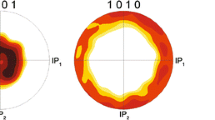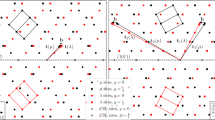Abstract
Twin boundaries (TBs) in ZnO sintered with small additions of Ga2O3 have been characterized with advanced methods of transmission electron microscopy (TEM). The TBs and accompanying inversion domain boundaries are on {011¯3} planes of ZnO. The Ga content of the TB corresponds to an effectively half occupied {011¯3} plane determined from compositional maps calculated from electron spectroscopic images using electron filtering TEM. The structure of the TBs were investigated by high-resolution TEM, and images of focus series were used to reconstruct the complex electron wave. Simulated electron waves based on structure models of the TB were quantitatively compared with the reconstructed wave to identify and to refine atom positions. The twins can be considered to be created by a mirror operation on a {011¯3} plane of ZnO, and two alternating closed-packed polyhedral clusters of oxygen ions can be identified as building units of the TB structure. Unit 1 is occupied with Zn2+ by simply continuing ZnO4 tetrahedra of the same type from both crystals to the TB. Using arguments of local charge balance unit 2 can only be occupied with the trivalent Ga3+ ion. The Ga3+ position was refined with high precision (±5 pm), and the resulting polyhedron is a GaO5 square pyramid. The pyramids form densely occupied columns parallel to the twin axis [21¯1¯0]. The analysis of the TB structure yields a fractional occupancy of the boundary plane by Ga of 0.5, which is in good agreement with the result of the chemical composition measurement with energy filtered TEM.
Similar content being viewed by others
References
F.C.M. Van de Pol, Ceram. Bull. 69, 1959 (1990).
T.K. Gupta, J. Am. Ceram. Soc. 73, 1817 (1990).
C. Wagner, J. Chem. Phys. 18, 62 (1950).
R. Wang, A.W. Sleight, and D. Cleary, Chem. Mater. 8, 433 (1996).
K.Y. Cheong, N. Muti, and S.R. Ramanan, Thin Solid Films 410, 142 (2002).
D. Makovec and M. Trontelj, J. Am. Ceram. Soc. 77, 1202 (1994).
N. Daneu, A. Rečnik, S. Bernik, and D. Kolar, J. Am. Ceram. Soc. 83, 3165 (2000).
A. Rečnik, N. Daneu, T. Walther, and W. Mader, J. Am. Ceram. Soc. 84, 2657 (2001).
M. Nakamura, N. Kimizuka, and T. Mohri, J. Solid State Chem. 86, 16 (1990).
C. Li, Y. Bando, M. Nakamura, M. Onoda, and N. Kimizuka, J. Solid State Chem. 139, 347 (1998).
C. Li, Y. Bando, M. Nakamura, K. Kurashima, and N. Kimizuka, Acta Cryst. B55, 355 (1999).
J. Barf and W. Mader, J. Solid State Chem., (submitted).
T. Walther, J. Barf, and W. Mader, in Proceedings of the 12th European Congress on Electron Microscopy, EUREM 12, edited by L. Frank and F. Čiampor (the Czechoslovak Society for Electron Microscopy, Brno, Czech Republic, 2000), Vol. 2, p. 409.
J. Barf, T. Walther, A. Steinecker, and W. Mader, Microscopy and Microanalysis 7, 239; Supplement 2, in Proceedings of Microscopy and Microanalysis 2001, edited by C.E. Lyman (Microscopy Society of America, Bethlehem, PA, USA;Springer, New York, 2001).
A. Steinecker and W. Mader, Ultramicrosopy 81, 149 (2000).
M. Op de Beeck, D. van Dyck, and W.M.J. Coene, Ultramicrosopy 64, 167 (1996).
M. Albrecht, V. Grillo, J. Borysiuk, T. Remmele, H.P. Strunk, T. Walther, W. Mader, P. Prystawko, M. Leszczynski, I. Grzegory, and S. Porowski, in Inst.Phys.Conf.Ser.169, edited by A.G. Cullis and J.L. Hutchison (Institute of Physics Publishing, Bristol, 2001), p. 267.
T. Walther, C.J. Humphreys, A.G. Cullis, and D.J. Robbins, Mater. Sci. Forum 196, 505 (1995).
G. Kalonji, J. Physique 46, coll. 4, 249 (1985).
R. Kilaas, CrytsalKit (Berkeley, California, 1995), Version 1.8.2.
R.C. Pond, D.A. Smith, and V. Vitek, Scripta Metall. 12, 699 (1978).
M.F. Ashby, F. Spaepen, and S. Williams, Acta Metall. 26, 1647 (1978).
V. Vitek, A.P. Sutton, D.A. Smith, and R.C. Pond, in Grain Boundary Structure and Kinetics, edited by R.W. Balluffi (American Society for Metals, Metals Park, Ohio, 1980), p. 115.
C.L. Jia and A. Thust, Phys. Rev. Lett. 82, 5152 (1999).
G. Möbus and M. Rühle, Ultramicrosopy 56, 54 (1994).
S. Geller, J. Chem. Phys. 33, 676 (1960).
M. Marezio, Acta Cryst. 18, 481 (1965).
M. Marezio and J.P. Remeika, J. Chem. Phys. 46, 1862 (1967).
J. Hornstra and E. Keulen, Philips Research Reports 27, 76 (1972).
W. Marti, P. Fischer, F. Altorfer, H.J. Schell, and M. Tadin, J. Phys.: Condens. Matter 6, 127 (1994).
Author information
Authors and Affiliations
Rights and permissions
About this article
Cite this article
Barf, J., Walther, T. & Mader, W. Twin Boundaries in Zinc Oxide with Additions of Gallium Oxide. Interface Science 12, 213–226 (2004). https://doi.org/10.1023/B:INTS.0000028651.74657.2b
Issue Date:
DOI: https://doi.org/10.1023/B:INTS.0000028651.74657.2b




